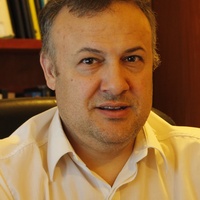Papers by Stefan Dickmann
2021 IEEE International Joint EMC/SI/PI and EMC Europe Symposium
Advances in Radio Science
In this paper, a method for the extraction of data for a through-hole vertical interconnect acces... more In this paper, a method for the extraction of data for a through-hole vertical interconnect access (via) on a printed circuit board (PCB) is presented. It uses a matrix de-embedding algorithm and two-port theory to extract the elements of an assumed lumped via model. After that the influence of the via on the power-bus impedance and the coupling between the via and the power-bus are described using this model.

Advances in Radio Science
The EMC properties of a cubic metallic shield are highly affected by its resonances. At the reson... more The EMC properties of a cubic metallic shield are highly affected by its resonances. At the resonant frequencies, the shielding effectiveness (SE) collapses, which results in high field strengths inside the cavity. This can cause failure or even breakdown of electronic devices inside the shield. The resonant behaviour is mainly determined by the quality or <i>Q</i> factor of the shield. In this paper, the effects of the aperture size on the <i>Q</i> factor and the SE of an electrically large, cubic shield are analysed. At first, a method is developed in order to determine the <i>Q</i> factor based on the resonance behaviour of the shield in time domain. Only the first resonance of the shield is considered therefore. The results are evaluated for different aperture diameters and compared with theory for the <i>Q</i> factor. The dominant coupling mechanism of electromagnetic energy into the shield is thus identified. <br><br>...
2014 International Symposium on Electromagnetic Compatibility, Sep 1, 2014
ABSTRACT This paper deals with a new possibility to protect a HVDC grid supplied by fuel cell sys... more ABSTRACT This paper deals with a new possibility to protect a HVDC grid supplied by fuel cell systems. An overcurrent time protection is not suitable for main bus protection due to the limited short circuit capability of fuel cell systems. A possibility could be an expensive oversizing of the fuel cell stack as it could be done with conventional generators to provide the required short circuit capability. However, such a solution leads to a strong increase of the stack weight and should be avoided. The innovative undervoltage time protection is an appropriate and low priced alternative as a passive grid protection for fuel cell systems. A simulation and a prototype measurement prove und demonstrated the feasibility. Finally, the investigated undervoltage time protection is not limited for fuel cell systems but can be also used for other DC applications.
Japanese Journal of Applied Physics, May 15, 1993
Polymer-dispersed liquid-crystal (PDLC) cells are prepared using a UV-curable methacrylate prepol... more Polymer-dispersed liquid-crystal (PDLC) cells are prepared using a UV-curable methacrylate prepolymer and nematic liquid crystals with a positive or a negative dielectric anisotropy. Memory effects, created by the phase transitions from an isotropic to a nematic phase with application of a magnetic field, of light transmission properties of the PDLC cells are described and their angular dependence is measured and
Http Dx Doi Org 10 1080 00150193 1996 10399398, Jun 1, 2011

2013 48th International Universities' Power Engineering Conference (UPEC), 2013
ABSTRACT An approach to achieve a high efficiency for energy transfer in modern aircraft could be... more ABSTRACT An approach to achieve a high efficiency for energy transfer in modern aircraft could be the More Electric Aircraft concept. According to this, the replacement of the conventional auxiliary power unit by a multi functional fuel cell system reduces the emission of carbondioxide significantly and can increase the efficiency. However, requirements on the electrical system dynamics are higher than currently available fuel cell systems can provide. To improve the electrical dynamics of the fuel cell especially during high peak power demands different methods are considered. This paper compares four possible integration scenarios to improve the system dynamic. Special characteristics as the additional system weight, the stored available energy, the complexity as well as the feasibility under the required conditions are considered. For supplementing the theoretical concepts, a prototype of a super capacitor short-time energy storage was built and integrated into an existing fuel cell test bench. Therefore, a voltage balancing as well as an overvoltage protection is implemented. Measurements show the improved dynamic of the hybrid fuel cell system.
2015 IEEE International Symposium on Electromagnetic Compatibility (EMC), 2015

In this contribution, a comprehensive approach to predicting conducted emissions produced by a sw... more In this contribution, a comprehensive approach to predicting conducted emissions produced by a switched-mode power converter is presented. The prediction is based on a SPICE model. As an example, a DC-DC-converter is analyzed. Both the semiconductors (MOSFET, diode etc.) and the passive discrete elements as inductors and capacitors are modeled by processing datasheet information, manufacturer-provided models and/or measurements. In order to include parasitic inductances of a converter's printed circuit board in the model, the concept of partial inductances is applied. The parasitic inductance extraction is merely based on CAD/layout data of the PCB. Hence, an existing prototype of the switched-mode power converter's printed circuit board is not required to perform the prediction. Thus, the prediction can be done early in the development process. To ensure comparability of prediction results and EMC regulation measurements, the measurement setup (line impedance stabilization ...

International Symposium on Electromagnetic Compatibility - EMC EUROPE, 2012
ABSTRACT In this paper an analysis of a method to damp resonances inside a screened room is done.... more ABSTRACT In this paper an analysis of a method to damp resonances inside a screened room is done. The room shall be part of a big system, e.g. a ship. This implies that it cannot be shielded electromagnetically to a high degree as it must contain connections to its exterior like cables, venting slots and doors. If the system is exposed to high field strengths, caused e.g. by an electromagnetic pulse (EMP) or intentional electromagnetic interference (IEMI), resonances are excited in that room. At the resonance frequencies, the room acts as an antenna and the shielding mechanisms collapse. It may contain electromagnetically sensitive devices, that have to be protected against electromagnetic interference (EMI). A possibility to suppress the resonances is inserting absorber material into the room. In this paper a screened enclosure with an aperture is analyzed with and without absorber lining on the wall opposite to the aperture in order to obtain the damping of the resonances in the cavity. Measurement and simulation of the damping are done in order to verify each other. For the simulation the permittivity of the absorber material has to be known. It is measured by the transmission/reflection method using the Nicolson-Ross-Weir algorithm. The results show that resonances in screened rooms can be damped in this way by up to 30 dB.
Electromagnetic Compatibility, 2006. …, 2006
In this paper the impact of lumped elements connected asymmetrically to rectangular PCB power-bus... more In this paper the impact of lumped elements connected asymmetrically to rectangular PCB power-bus structures is investigated and a double summation expression for the resulting impedance is derived. Further, the double summation expression is ...
Electromagnetic Compatibility, 2005. …, 2005
An effective and cost efficient method for suppressing cavity mode resonances within the power-bu... more An effective and cost efficient method for suppressing cavity mode resonances within the power-bus of high-speed printed circuit boards is presented. It is shown that resonant modes can be completely suppressed by segmenting the power-bus into ...
2014 International Symposium on Electromagnetic Compatibility, Sep 1, 2014
2015 IEEE International Symposium on Electromagnetic Compatibility (EMC), 2015
2009 IEEE International Symposium on Electromagnetic Compatibility, 2009
ABSTRACT In this paper, lumped models are used to describe the effects of vias in multilayered PC... more ABSTRACT In this paper, lumped models are used to describe the effects of vias in multilayered PCBs. Possible effects of a via on a 4-layer PCB are explained and investigated: the coupling between the via and the power-bus, and the influence on the signal propagation at the via transition. In addition, a computation procedure using lumped models for PCBs with more than 4 layers is presented and some special effects on a via are explained. Finally, another possible coupling mechanism, the direct coupling of the waveguide modes from the power-bus into a stripline is investigated.
2009 20th International Zurich Symposium on Electromagnetic Compatibility, 2009
ABSTRACT
2008 International Symposium on Electromagnetic Compatibility - EMC Europe, 2008
ABSTRACT









Uploads
Papers by Stefan Dickmann